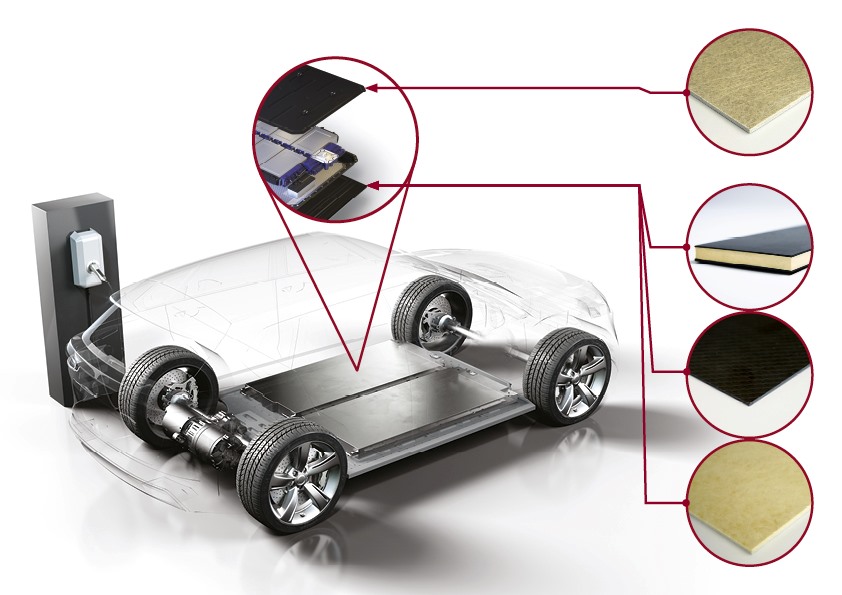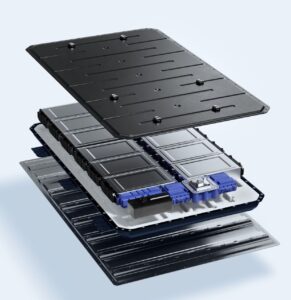
Huntsman provides a range of epoxy- and polyurethane-based composite solutions for EV battery, interior and exterior applications.
Polyurethane and epoxy resins can provide the innovative material solutions required to help meet the unique challenges of electric vehicle components and bodies.
Polyurethanes, specifically, have much to offer due to their thermal profile; high flexibility; resiliency and vibration resistance; excellent tensile properties; strong adhesive properties; chemical and abrasion resistance; and durability.
Automotive Industries (AI) asked Irina Bolshakova – Global Marketing Director Automotive – Polyurethanes at Huntsman, to introduce the company’s new polyurethane and epoxy composites portfolio.
Bolshakova: We have developed an innovative portfolio of resin products that can help support the automotive industry’s transition to electrification and intelligent mobility.
To help further the adoption of electric vehicles, we provide a range of epoxy- and polyurethane-based composite solutions for EV battery, interior and exterior applications.
Optimized to help automotive suppliers and OEMs increase productivity and deliver advanced performance with lower carbon emissions compared to incumbent solutions, these products can help meet growing performance requirements, while they also may help to reduce environmental impact.

AI: Are you targeting the automotive industry’s transition towards electrified vehicles specifically with the range?
Bolshakova: Yes. Electrification in the automotive industry is one of the key challenges in the sector – and there are stringent safety and advanced performance requirements that material manufacturers must deliver on.
We work closely alongside our automotive customers – providing them with development support from initial concept creation through to the final large-scale production of components.
At every stage the focus is on creating composite solutions that can help reduce EV battery weight while providing the necessary structural and thermal protection required to enhance passenger safety and help optimize battery operation and overall vehicle performance.
AI: What does the new glass fiber-reinforced, polyurethane composite technology RIMLINE® RSM system offer for rear seat pan applications?
Bolshakova: Our RIMLINE® RSM resin system can help provide structural support while offering design flexibility to meet required seat geometries.
Delivered via spray-molding, this product can support efficient manufacturing requirements, offering short cycle times and flexible processing conditions.
The opportunity to improve manufacturing productivity is in addition to the surface quality, structural support and durability that this system can help to deliver in final produced parts.
AI: What are the benefits and differentiation of your portfolio of VITROX® and RIMLINE® ranges of customizable, quick cure, high strength polyurethane resins?
Bolshakova: Our VITROX® and RIMLINE® system solutions have been developed to help meet the needs of battery integrators and OEMs. Our RIMLINE® solutions are formulated as a standard cross-linked polyurethane, enabling high toughness and durability combined with a high reactivity and fast cure.
Developed to provide design flexibility and support efficient production, these products can be used in a range of applications, including the creation of lightweight underfloor panels for EV battery protection.
For example, our RIMLINE® FC (foam core) system may be suitable for creating lightweight sandwich composite panels and can be overmolded with RIMLINE® WCM composite layers.
Our RIMLINE® LFI core technology can help increase impact resistance and durability of composite sandwich panels.
Our VITROX® product portfolio is a family of highly cross-linked isocyanate resins with a tunable glass transition temperature (Tg) that offer flexible, adjustable open times; and snap cure capabilities, which can help provide accurate control over parts processing.
Products in this range have been developed to help create parts of varying thickness levels and to be processed in a number of different ways (wet compression or compression spray molding).
Typical benefits can include high toughness levels. These products also have the potential to deliver thermal and structural protection of different elements and potentially complete parts of battery enclosures, top covers, heat shields and underfloor protection.
The VITROX® product family can also help to achieve increased fire protection thanks to the formulation expertise of our team and the targeted raw material choices they can help customers make.

AI: How are your latest RIMLINE® and VITROX® polyurethane resin systems for composite battery enclosures, trays, and underbody shields, developed to meet customer requirements?
Bolshakova: Our polyurethanes-based composite portfolio is built on the following pillars: maximizing performance; optimizing process; and aiming to reduce environmental impact.
Sticking closely to these pillars ensures that our products are optimized to help deliver what our customers need.
Obviously, the key customer requirement at the moment is to produce high performance lightweight technologies that can support the continued adoption of electric vehicles.
Recent innovations developed to align with this goal include:
Developed for battery top cover applications
VITROX® WCM – a polyurethane system, which can help customers to achieve fire and structural protection standards. The system can help to improve battery performance through durability and thermal protection, which in turn may help maximize the lifetime of batteries.
Developed for battery underfloor applications, product options
RIMLINE® WCM – a polyurethane system which can help to improve impact protection and structural support. Using this product, automotive part producers have the potential to increase productivity levels thanks to short cycle times, while aiming to deliver the advanced structural support required by car manufacturers.
RIMLINE® FC / RIMLINE® LFI – these two polyurethane systems can be used to create lightweight and load bearing cores for underfloor sandwich panels.
Advanced performance in sandwich structures can help reduce weight, opening up opportunities for lower energy consumption.
RIMLINE® SRIM – a polyurethane system that can be injection molded to create the core of sandwich composite structures.
Can Huntsman’s polyurethane resins help customers reduce the carbon footprint of materials – without compromising on performance, and while avoiding lengthy and costly re-qualifications?
Bolshakova: Our polyurethane-based composite technologies can help address some key sustainability challenges.
Thanks to the intrinsic properties inherent to our chemistry, we can achieve fast curing capabilities (low energy use) and reduced emissions (low VOC) compared to commonly used PU technologies.
Our products can also help support waste reduction, durability (extending the lifetime of components), and lightweighting (lower fuel consumption).
Our composites resins can also be offered as ISCC PLUS mass balance certified to support customers’ sustainability and net zero ambitions.
AI: Are all polyurethane resin systems presented at JEC World, Mass Balance Certified from your ISCC PLUS certified production sites?
Bolshakova: We pride ourselves on working flexibly with our customers to deliver what they need. As such, many of the products in our polyurethane portfolio can include components, such as isocyanate, supplied with ISCC PLUS certification – and we are always happy to discuss these options with our customers.
AI: What are your three main development routes towards more sustainable solutions?
Bolshakova: There are three main development routes that Huntsman is pursuing as it works towards the development of more sustainable solutions:
Raw Materials
Huntsman’s commitment to sustainability begins with sourcing raw materials responsibly. By focusing on replacing fossil-based benzene and propylene oxide used as polyurethane manufacturing raw materials, we aim to reduce the environmental impact of our processes and support a low carbon and circular economy.
Collaboration and Acceptance
Huntsman actively collaborates with partners and suppliers to promote the adoption of bio-based and recycled raw materials within its polyurethane systems. Aiming to get acceptance for these materials, we can help contribute to a more sustainable supply chain.
Recyclability and Innovation
Huntsman is actively looking toward technologies that can help enhance the recyclability of automotive parts and components. For instance, we obtained ISCC PLUS certification, demonstrating our commitment to sustainable practices.
Additionally, we have polyurethane systems in development – RIMLINE® FC and RIMLINE® HC systems – that can incorporate bio- and recycled materials and can lead to reduced CO2 emissions compared to existing technologies. Looking further ahead, we are also exploring next-generation recyclable thermoset resin systems.
Together, these efforts reflect our dedication to helping the automotive industry work towards a more sustainable future.
AI: What is next for Huntsman?
Bolshakova: Addressing the automotive industry’s technological and circular challenges in close cooperation with our customers sets the foundation of our future developments.
With this objective in mind, our products are developed to provide the highest values in performance, safety and advanced processing, while aiming to reduce environmental impact.
Current and future developments focus on the integration of circular solutions into our PU technologies for composites – e.g., using recycled and bio-based content.
The creation of these technologies will further foster and support the circular economy ambitions of the automotive industry.
For more information: www.huntsman.com/batterymaterials
Disclaimer
While all the information and recommendations in this publication are to the best of our knowledge, information and belief accurate at the date of publication, nothing herein is to be construed as a warranty, express or otherwise.
Huntsman warrants only that its products meet the agreed specifications. Typical properties, where stated, are to be considered as representative of current production and should not be treated as specifications.
In all cases, it is the responsibility of the user to determine the applicability of such information and recommendations and the suitability of any product for its own particular purpose.
The sale of products referred to in this publication is subject to the general terms and conditions of sale of Huntsman International LLC or of its affiliated companies.
RIMLINE® and VITROX® are registered trademarks of Huntsman Corporation or an affiliate thereof in one or more, but not all, countries.
© 2024. Huntsman Corporation or an affiliate thereof. All rights reserved.













More Stories
Some Ways How Motorists End Up in Collisions at U-Turns
Maximise Margins with Proven PPF Tactics
Finding the Car Boot Release Button – Tips and Tricks